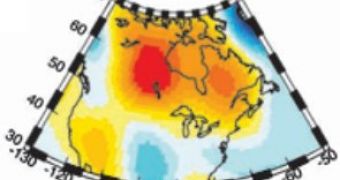Common sense tells us that the Earth's gravitational force should be equal all around the world. Well, it's not! The inhabitants of northern Canada may not be numerous, but they are the slimmest people on the planet.
A new study shows that that specific region of the country feels less gravitational pull than the rest of the planet. They're not exactly floating around like astronauts in space though, since the difference is only about four thousands of a percent.
However, this is enough to help scientists tease out some important clues about the last ice age and the dynamics of the mantle underlying Earth's crust.
They know that around 20,000 years ago, a large part of North America was covered by the Laurentide Ice Sheet, a massive glacier more than 3 kilometers thick in some locations.
This was enough to cause some of the bedrock to compress and sink, thus displacing the semifluid mantle beneath. The effects were most profound in two regions of northern Canada flanking Hudson Bay, where the ice formed two huge domes.
Theorists had predicted that Earth's gravity retained the echoes of the glacial domes as a pair of dimples where the force is reduced.
Now, a team led by geophysicist Mark Tamisiea of the Harvard-Smithsonian Center for Astrophysics in Cambridge, Massachusetts used NASA's twin Gravity Recovery and Climate Experiment (GRACE) satellites to create a map of the two gravitational anomalies.
"The observations tell us a great deal about the crust and mantle," he specifically said about the deformation and recovery rates.
Their results confirmed that gravity is about 1/25,000 weaker in the two regions. Tamisiea said that based on observations from the GRACE satellites over four years ending in 2006, it will take up to 300,000 years for the regions' gravity to return to normal.

 14 DAY TRIAL //
14 DAY TRIAL //